Construction Management: Building Regulations Compliance Report
VerifiedAdded on 2023/06/03
|6
|1100
|410
Report
AI Summary
This construction management report examines the building regulations applicable to a residential apartment block on Hamilton Island, Queensland, focusing on compliance and deficiencies. The report addresses active fire control measures, including emergency lighting, exit signs, and smoke detection systems, ensuring occupant safety during emergencies. It also covers fire hydrants, fire hose reels, and access considerations, such as stair construction and handrails, while adhering to the Australian Building Code (BCA). Furthermore, the report emphasizes disabled access, health, amenity, and energy efficiency, incorporating relevant clauses and standards to ensure a safe and compliant building design. The analysis includes site-specific risk factors, such as wind class, and incorporates references to relevant building codes and standards throughout the assessment.
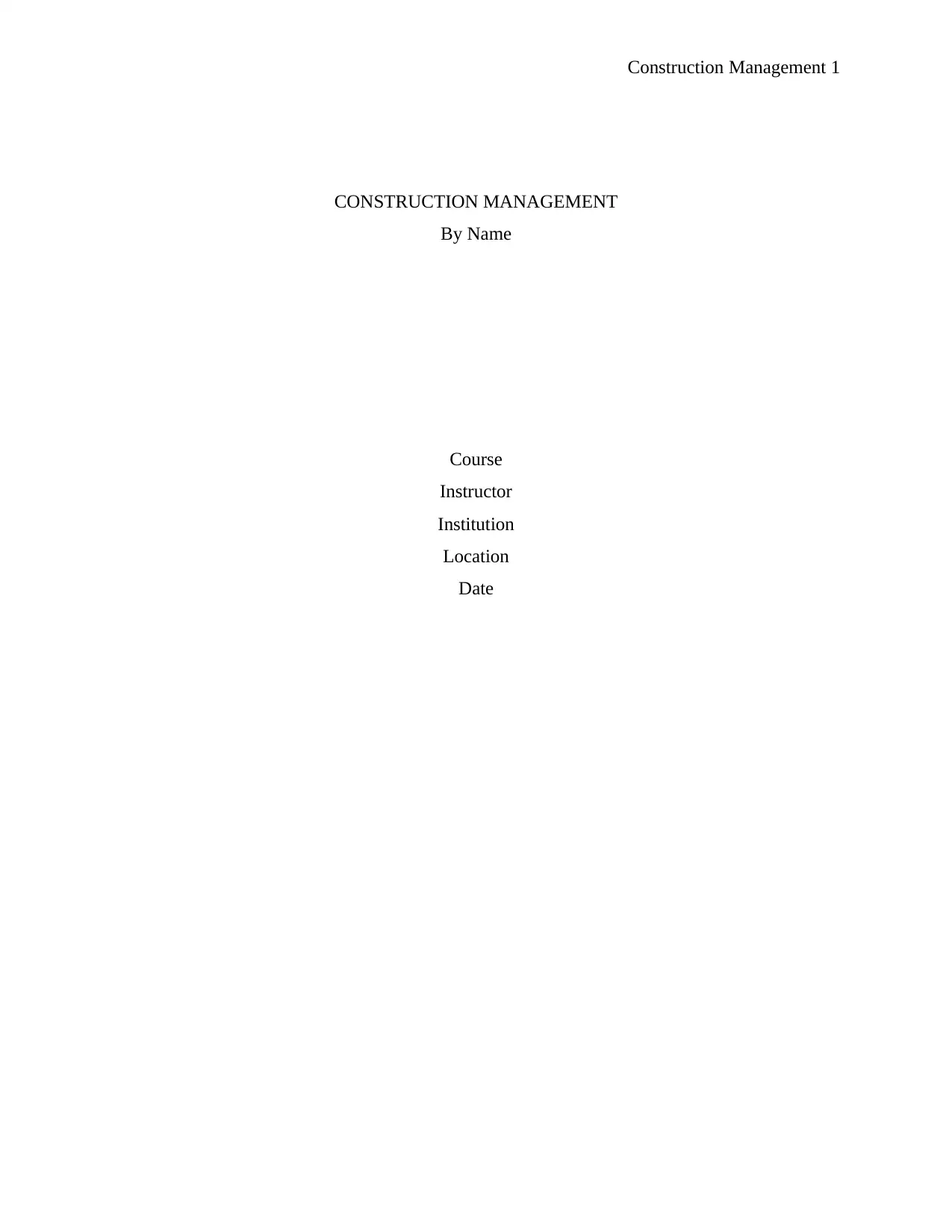
Construction Management 1
CONSTRUCTION MANAGEMENT
By Name
Course
Instructor
Institution
Location
Date
CONSTRUCTION MANAGEMENT
By Name
Course
Instructor
Institution
Location
Date
Paraphrase This Document
Need a fresh take? Get an instant paraphrase of this document with our AI Paraphraser
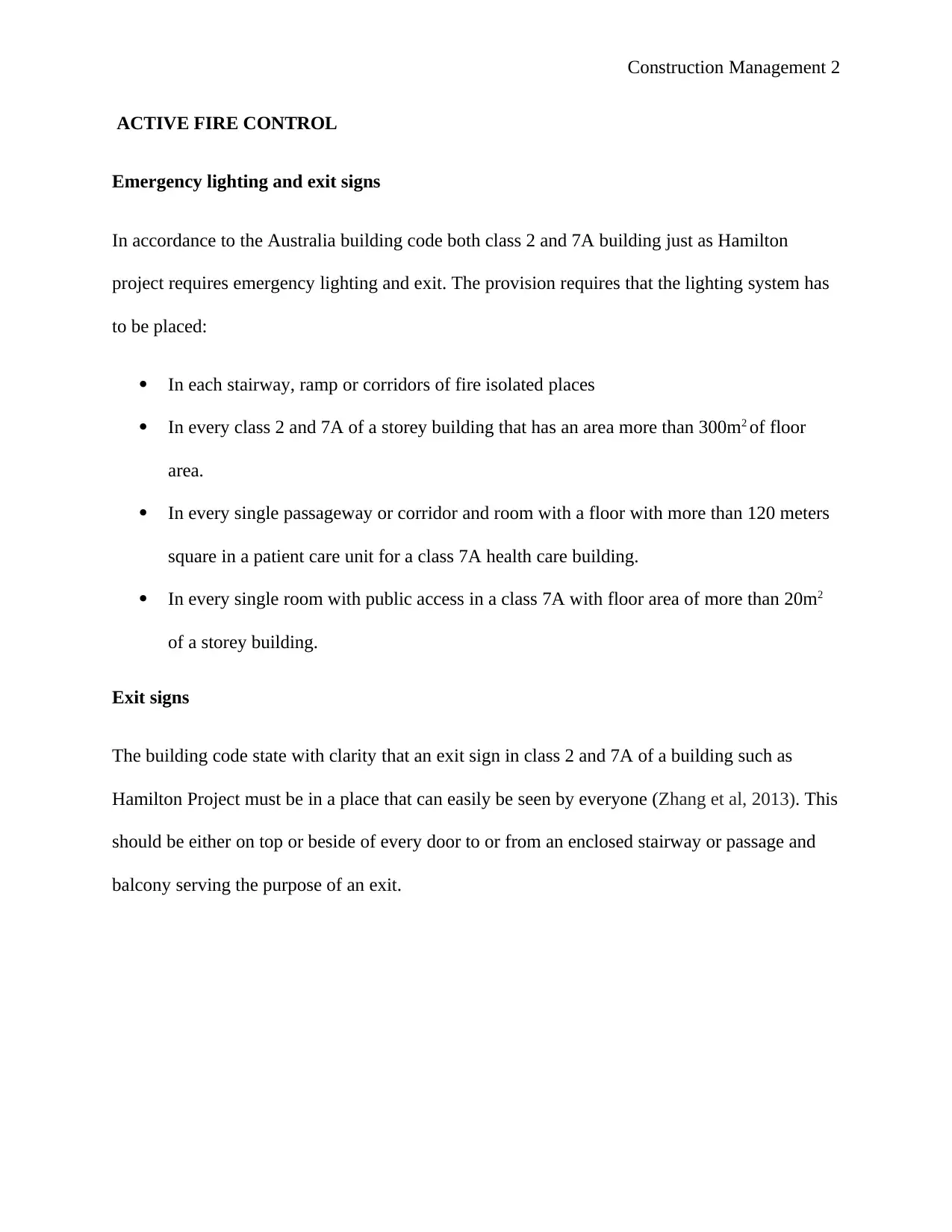
Construction Management 2
ACTIVE FIRE CONTROL
Emergency lighting and exit signs
In accordance to the Australia building code both class 2 and 7A building just as Hamilton
project requires emergency lighting and exit. The provision requires that the lighting system has
to be placed:
In each stairway, ramp or corridors of fire isolated places
In every class 2 and 7A of a storey building that has an area more than 300m2 of floor
area.
In every single passageway or corridor and room with a floor with more than 120 meters
square in a patient care unit for a class 7A health care building.
In every single room with public access in a class 7A with floor area of more than 20m2
of a storey building.
Exit signs
The building code state with clarity that an exit sign in class 2 and 7A of a building such as
Hamilton Project must be in a place that can easily be seen by everyone (Zhang et al, 2013). This
should be either on top or beside of every door to or from an enclosed stairway or passage and
balcony serving the purpose of an exit.
ACTIVE FIRE CONTROL
Emergency lighting and exit signs
In accordance to the Australia building code both class 2 and 7A building just as Hamilton
project requires emergency lighting and exit. The provision requires that the lighting system has
to be placed:
In each stairway, ramp or corridors of fire isolated places
In every class 2 and 7A of a storey building that has an area more than 300m2 of floor
area.
In every single passageway or corridor and room with a floor with more than 120 meters
square in a patient care unit for a class 7A health care building.
In every single room with public access in a class 7A with floor area of more than 20m2
of a storey building.
Exit signs
The building code state with clarity that an exit sign in class 2 and 7A of a building such as
Hamilton Project must be in a place that can easily be seen by everyone (Zhang et al, 2013). This
should be either on top or beside of every door to or from an enclosed stairway or passage and
balcony serving the purpose of an exit.
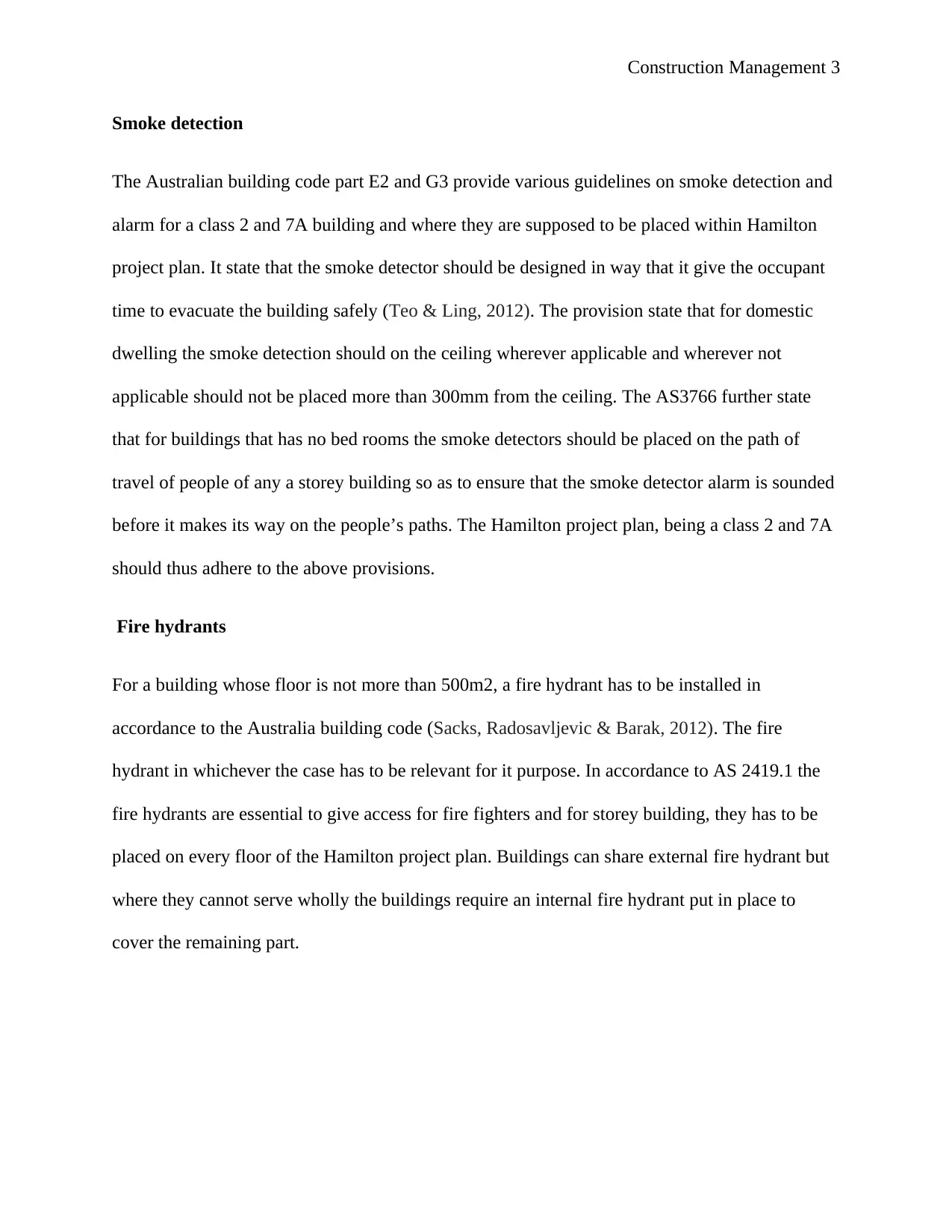
Construction Management 3
Smoke detection
The Australian building code part E2 and G3 provide various guidelines on smoke detection and
alarm for a class 2 and 7A building and where they are supposed to be placed within Hamilton
project plan. It state that the smoke detector should be designed in way that it give the occupant
time to evacuate the building safely (Teo & Ling, 2012). The provision state that for domestic
dwelling the smoke detection should on the ceiling wherever applicable and wherever not
applicable should not be placed more than 300mm from the ceiling. The AS3766 further state
that for buildings that has no bed rooms the smoke detectors should be placed on the path of
travel of people of any a storey building so as to ensure that the smoke detector alarm is sounded
before it makes its way on the people’s paths. The Hamilton project plan, being a class 2 and 7A
should thus adhere to the above provisions.
Fire hydrants
For a building whose floor is not more than 500m2, a fire hydrant has to be installed in
accordance to the Australia building code (Sacks, Radosavljevic & Barak, 2012). The fire
hydrant in whichever the case has to be relevant for it purpose. In accordance to AS 2419.1 the
fire hydrants are essential to give access for fire fighters and for storey building, they has to be
placed on every floor of the Hamilton project plan. Buildings can share external fire hydrant but
where they cannot serve wholly the buildings require an internal fire hydrant put in place to
cover the remaining part.
Smoke detection
The Australian building code part E2 and G3 provide various guidelines on smoke detection and
alarm for a class 2 and 7A building and where they are supposed to be placed within Hamilton
project plan. It state that the smoke detector should be designed in way that it give the occupant
time to evacuate the building safely (Teo & Ling, 2012). The provision state that for domestic
dwelling the smoke detection should on the ceiling wherever applicable and wherever not
applicable should not be placed more than 300mm from the ceiling. The AS3766 further state
that for buildings that has no bed rooms the smoke detectors should be placed on the path of
travel of people of any a storey building so as to ensure that the smoke detector alarm is sounded
before it makes its way on the people’s paths. The Hamilton project plan, being a class 2 and 7A
should thus adhere to the above provisions.
Fire hydrants
For a building whose floor is not more than 500m2, a fire hydrant has to be installed in
accordance to the Australia building code (Sacks, Radosavljevic & Barak, 2012). The fire
hydrant in whichever the case has to be relevant for it purpose. In accordance to AS 2419.1 the
fire hydrants are essential to give access for fire fighters and for storey building, they has to be
placed on every floor of the Hamilton project plan. Buildings can share external fire hydrant but
where they cannot serve wholly the buildings require an internal fire hydrant put in place to
cover the remaining part.
⊘ This is a preview!⊘
Do you want full access?
Subscribe today to unlock all pages.

Trusted by 1+ million students worldwide
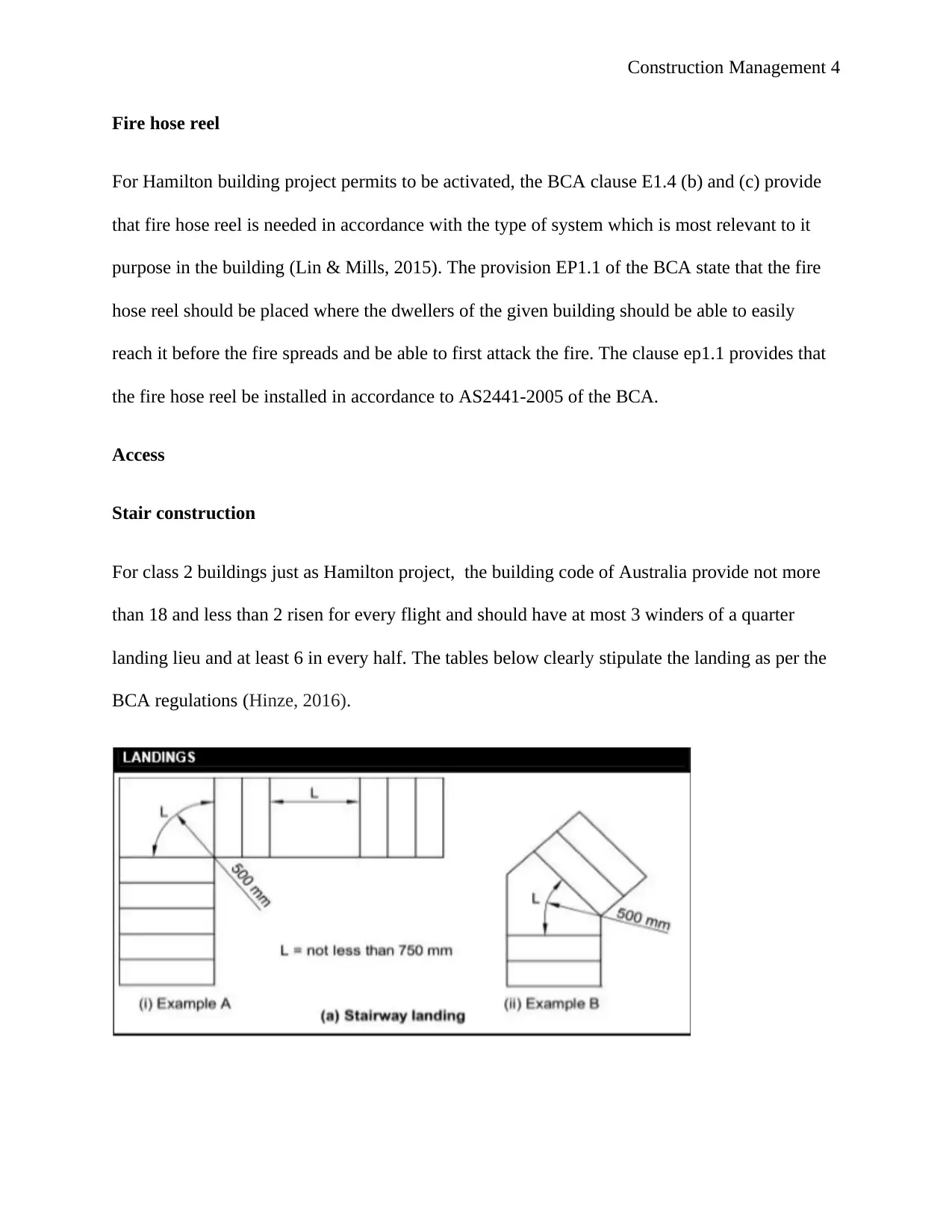
Construction Management 4
Fire hose reel
For Hamilton building project permits to be activated, the BCA clause E1.4 (b) and (c) provide
that fire hose reel is needed in accordance with the type of system which is most relevant to it
purpose in the building (Lin & Mills, 2015). The provision EP1.1 of the BCA state that the fire
hose reel should be placed where the dwellers of the given building should be able to easily
reach it before the fire spreads and be able to first attack the fire. The clause ep1.1 provides that
the fire hose reel be installed in accordance to AS2441-2005 of the BCA.
Access
Stair construction
For class 2 buildings just as Hamilton project, the building code of Australia provide not more
than 18 and less than 2 risen for every flight and should have at most 3 winders of a quarter
landing lieu and at least 6 in every half. The tables below clearly stipulate the landing as per the
BCA regulations (Hinze, 2016).
Fire hose reel
For Hamilton building project permits to be activated, the BCA clause E1.4 (b) and (c) provide
that fire hose reel is needed in accordance with the type of system which is most relevant to it
purpose in the building (Lin & Mills, 2015). The provision EP1.1 of the BCA state that the fire
hose reel should be placed where the dwellers of the given building should be able to easily
reach it before the fire spreads and be able to first attack the fire. The clause ep1.1 provides that
the fire hose reel be installed in accordance to AS2441-2005 of the BCA.
Access
Stair construction
For class 2 buildings just as Hamilton project, the building code of Australia provide not more
than 18 and less than 2 risen for every flight and should have at most 3 winders of a quarter
landing lieu and at least 6 in every half. The tables below clearly stipulate the landing as per the
BCA regulations (Hinze, 2016).
Paraphrase This Document
Need a fresh take? Get an instant paraphrase of this document with our AI Paraphraser
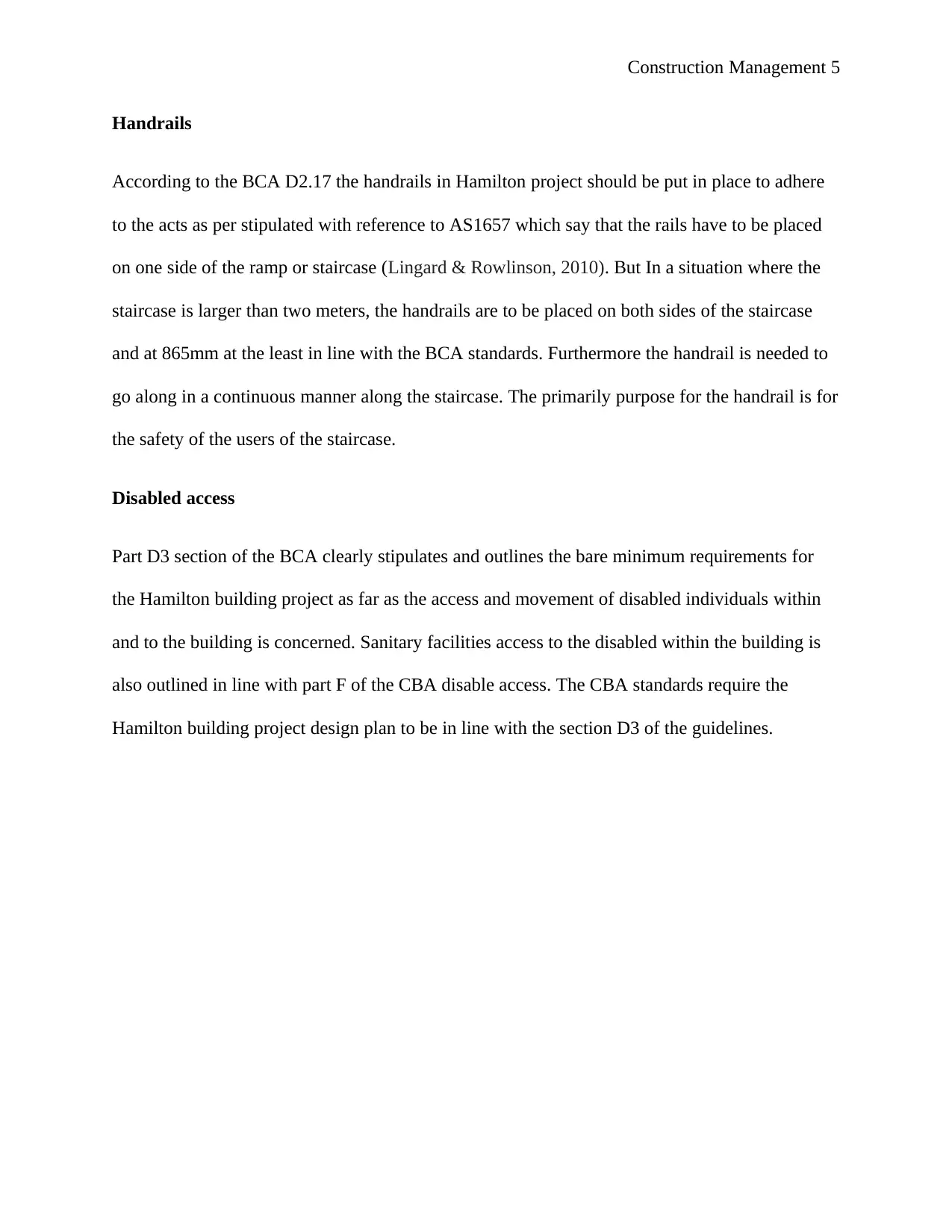
Construction Management 5
Handrails
According to the BCA D2.17 the handrails in Hamilton project should be put in place to adhere
to the acts as per stipulated with reference to AS1657 which say that the rails have to be placed
on one side of the ramp or staircase (Lingard & Rowlinson, 2010). But In a situation where the
staircase is larger than two meters, the handrails are to be placed on both sides of the staircase
and at 865mm at the least in line with the BCA standards. Furthermore the handrail is needed to
go along in a continuous manner along the staircase. The primarily purpose for the handrail is for
the safety of the users of the staircase.
Disabled access
Part D3 section of the BCA clearly stipulates and outlines the bare minimum requirements for
the Hamilton building project as far as the access and movement of disabled individuals within
and to the building is concerned. Sanitary facilities access to the disabled within the building is
also outlined in line with part F of the CBA disable access. The CBA standards require the
Hamilton building project design plan to be in line with the section D3 of the guidelines.
Handrails
According to the BCA D2.17 the handrails in Hamilton project should be put in place to adhere
to the acts as per stipulated with reference to AS1657 which say that the rails have to be placed
on one side of the ramp or staircase (Lingard & Rowlinson, 2010). But In a situation where the
staircase is larger than two meters, the handrails are to be placed on both sides of the staircase
and at 865mm at the least in line with the BCA standards. Furthermore the handrail is needed to
go along in a continuous manner along the staircase. The primarily purpose for the handrail is for
the safety of the users of the staircase.
Disabled access
Part D3 section of the BCA clearly stipulates and outlines the bare minimum requirements for
the Hamilton building project as far as the access and movement of disabled individuals within
and to the building is concerned. Sanitary facilities access to the disabled within the building is
also outlined in line with part F of the CBA disable access. The CBA standards require the
Hamilton building project design plan to be in line with the section D3 of the guidelines.
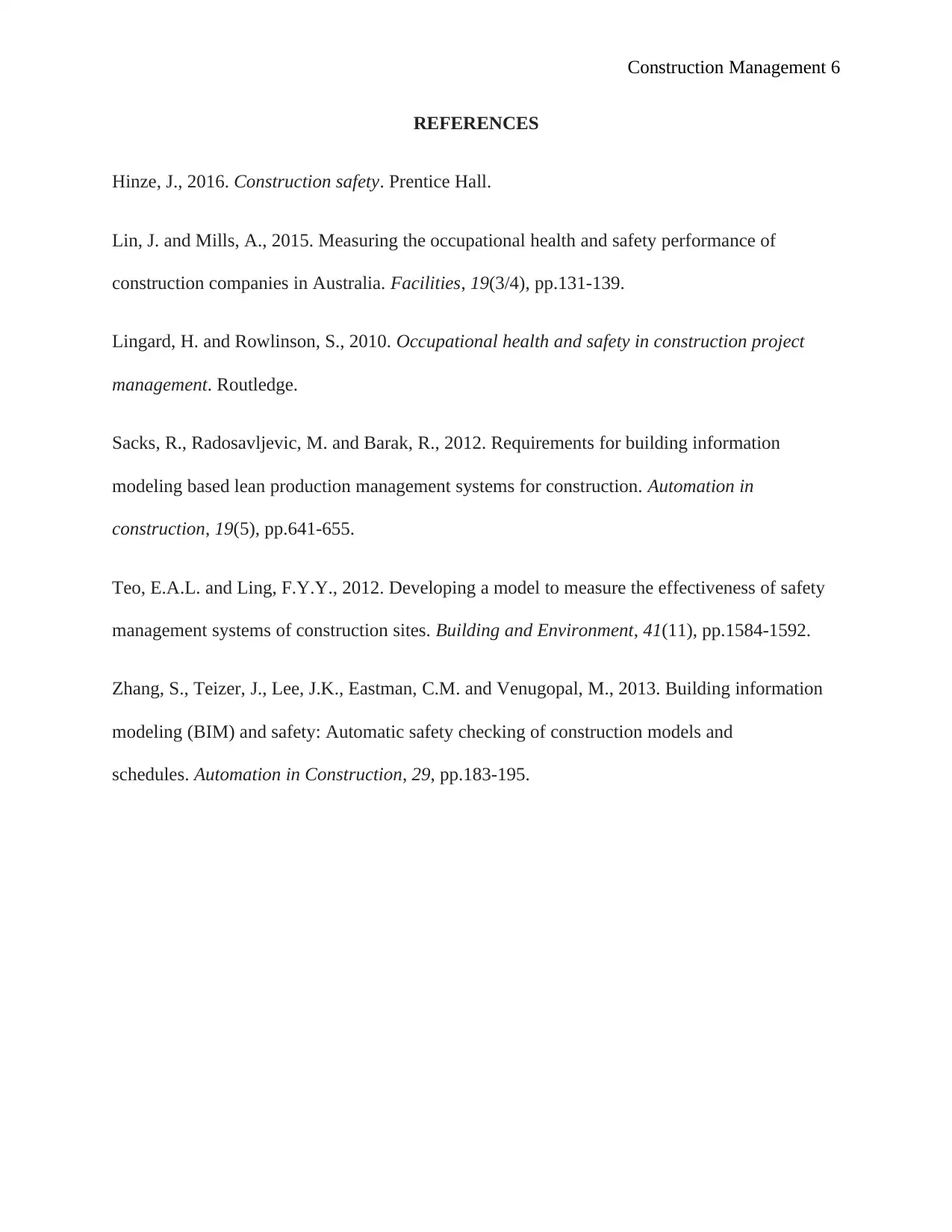
Construction Management 6
REFERENCES
Hinze, J., 2016. Construction safety. Prentice Hall.
Lin, J. and Mills, A., 2015. Measuring the occupational health and safety performance of
construction companies in Australia. Facilities, 19(3/4), pp.131-139.
Lingard, H. and Rowlinson, S., 2010. Occupational health and safety in construction project
management. Routledge.
Sacks, R., Radosavljevic, M. and Barak, R., 2012. Requirements for building information
modeling based lean production management systems for construction. Automation in
construction, 19(5), pp.641-655.
Teo, E.A.L. and Ling, F.Y.Y., 2012. Developing a model to measure the effectiveness of safety
management systems of construction sites. Building and Environment, 41(11), pp.1584-1592.
Zhang, S., Teizer, J., Lee, J.K., Eastman, C.M. and Venugopal, M., 2013. Building information
modeling (BIM) and safety: Automatic safety checking of construction models and
schedules. Automation in Construction, 29, pp.183-195.
REFERENCES
Hinze, J., 2016. Construction safety. Prentice Hall.
Lin, J. and Mills, A., 2015. Measuring the occupational health and safety performance of
construction companies in Australia. Facilities, 19(3/4), pp.131-139.
Lingard, H. and Rowlinson, S., 2010. Occupational health and safety in construction project
management. Routledge.
Sacks, R., Radosavljevic, M. and Barak, R., 2012. Requirements for building information
modeling based lean production management systems for construction. Automation in
construction, 19(5), pp.641-655.
Teo, E.A.L. and Ling, F.Y.Y., 2012. Developing a model to measure the effectiveness of safety
management systems of construction sites. Building and Environment, 41(11), pp.1584-1592.
Zhang, S., Teizer, J., Lee, J.K., Eastman, C.M. and Venugopal, M., 2013. Building information
modeling (BIM) and safety: Automatic safety checking of construction models and
schedules. Automation in Construction, 29, pp.183-195.
⊘ This is a preview!⊘
Do you want full access?
Subscribe today to unlock all pages.

Trusted by 1+ million students worldwide
1 out of 6
Related Documents
Your All-in-One AI-Powered Toolkit for Academic Success.
+13062052269
info@desklib.com
Available 24*7 on WhatsApp / Email
![[object Object]](/_next/static/media/star-bottom.7253800d.svg)
Unlock your academic potential
Copyright © 2020–2025 A2Z Services. All Rights Reserved. Developed and managed by ZUCOL.





